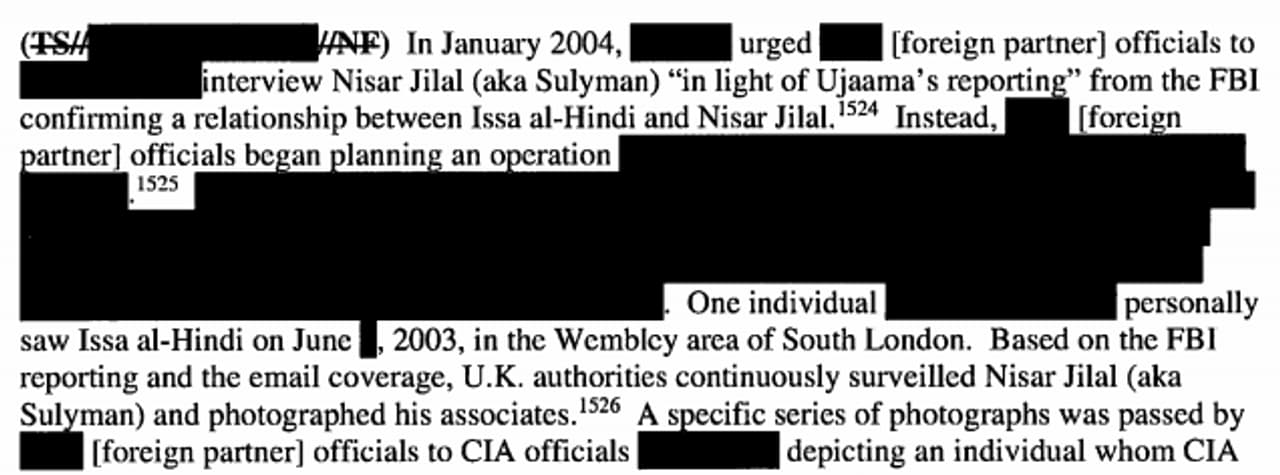
How the US Senate came to publish a damning report about CIA actions in secret prisons
A redacted section of the report discussing the CIA’s foreign partners
The US Senate Intelligence Committee officially decided to investigate the CIA‘s programme of secret detentions and “enhanced interrogation techniques” in March 2009.
This followed the 2007 revelation that the CIA had destroyed videotapes showing detainees held under its secret rendition programme being subjected to the interrogation technique known as waterboarding.
In December 2014, five years and nine months after the official decision to investigate the CIA’s actions, the intelligence committee published a summary of its findings.
The publication of the findings was delayed because the CIA, the White House and the chair of the committee, Senator Dianne Feinstein, argued over how much should be redacted.
Just three days before the report’s eventual publication, Secretary of State John Kerry called Feinstein asking her to consider further delaying its release.
Of the 6,000 pages in total only a 499 page portion, containing an executive summary and key findings, has been declassified for public release. Sections of the summary are heavily redacted.
But even this small section contains a substantial amount of previously undisclosed information about the Bush-era torture programme, including the number of CIA detainees (119), certain techniques (rectal feeding and hydration) and new details in cases of specific detainees.
The release of the report prompted calls across Europe for other governments to come clean about their own complicity in the CIA-managed programme. Two days after its publication Downing Street, for example, admitted that British spies had asked their US counterparts to censor key passages.
The Intelligence Committee is chaired by Senator Dianne Feinstein, who joined it at the beginning of 2001. In the foreword to the report she wrote that while the report was rightfully critical of the CIA’s actions, she tried to “remember the impact on the nation and to the CIA workforce from the attacks of September 11, 2001.”
The report makes clear that the potential illegality of the program was recognised from the beginning, with a cable from 2002 noting that prior to subjecting a detainee to enhanced interrogation, CIA officers sought assurances he would “remain in isolation and incommunicado for the remainder of his life”.
The report was strongly rejected by the CIA. Director John Brennan released a statement saying the practices “did produce intelligence that helped … save lives”.
Former CIA officials also publicly poured scorn on the report. In the Wall Street Journal former CIA directors George Tenet, Porter Goss and Michael Hayden wrote it was a “one-sided study marred by errors of fact and interpretation, essentially a poorly done and partisan attack on the agency that has done the most to protect America”.
The investigation relied on cables and documents produced during the CIA programme and no current or former CIA officials were interviewed for it. In the WSJ, the former CIA directors said “the Senate Intelligence investigators never spoke to us – the leaders of the agency whose policies they are now assailing.”
Dick Cheney, the former vice-president, was among the most vociferous critics of the Senate report. In a Fox News interview he said: “We asked the agency to go take steps and put in place programs that were designed to catch the bastards who killed 3,000 of us on 9/11 and make sure it didn’t happen again, and that’s exactly what they did, and they deserve a lot of credit.”
President Barack Obama said in his first televised remarks after the publication of the summary: “Nobody can fully understand what it was like to be responsible for the safety and security of the American people in the aftermath of the worst attack on our national soil. When countries are threatened, oftentimes they act rationally in ways that in retrospect were wrong.”
The investigation reportedly cost the US government more than $40m.
Read the full published summary here.
Follow Victoria Parsons on Twitter. Sign up to email updates from the Bureau here.



